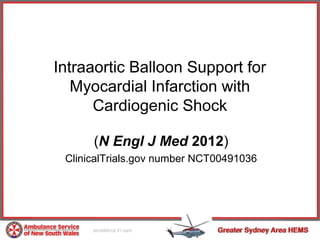
IABP for MI with cardiogenic shock
- 1. Intraaortic Balloon Support for Myocardial Infarction with Cardiogenic Shock (N Engl J Med 2012) ClinicalTrials.gov number NCT00491036
- 2. Background • The rate of death among patients with cardiogenic shock complicating acute myocardial infarction is high even when the patients undergo early revascularization with percutaneous coronary intervention (PCI) or coronary artery bypass grafting (CABG) • Intraaortic balloon counterpulsation is the most widely used form of mechanical hemodynamic support in this clinical setting • In U.S. and European guidelines, the use of an intraaortic balloon in the treatment of cardiogenic shock is given a class IB and class IC recommendation, respectively • However, evidence is based mainly on registry data, and there is a lack of adequately powered randomized trials
- 3. Objectives • The IABP-SHOCK II trial was designed to test the hypothesis that intraaortic balloon counterpulsation, as compared with the best available medical therapy alone, results in a reduction in mortality among patients with acute myocardial infarction complicated by cardiogenic shock for whom early revascularization is planned
- 4. Methods • Multicentre, open label, randomised, controlled trial • 37 centres in Germany • From June 16, 2009 to March 3, 2012 • Enrolment target 600 • 30 day follow up
- 5. Eligibility • Inclusion criteria – acute myocardial infarction (with or without ST-segment elevation) complicated by cardiogenic shock – early revascularization (by means of PCI or CABG) was planned – Informed consent
- 6. Eligibility • Exclusion criteria (typical contraindications for cardiogenic shock trials and IABP) – undergone resuscitation for >30 minutes – no intrinsic heart action – in a coma with fixed dilatation of pupils, not induced by drugs – mechanical cause of cardiogenic shock – onset of shock >12 hours – massive pulmonary embolism, severe peripheral arterial disease precluding insertion of an IABP, or aortic regurgitation – >grade II severity (on a scale of I to IV, with higher grades indicating more severe regurgitation) – >90 years of age – in shock as a result of a condition other than AMI – severe concomitant disease with associated life expectancy of <6 mths
- 7. Randomisation and blinding • Randomisation was performed centrally • Randomisation ratio of 1:1 using an Internet-based randomisation program • Stratification performed according to centre • Open label (no blinding)
- 8. Endpoints • Primary endpoint – 30-day all-cause mortality
- 9. Endpoints • Secondary endpoints – Serial assessments of serum lactate levels – Creatinine clearance (measured with the use of the Cockcroft–Gault formula) – C-reactive protein levels – Severity of disease as assessed by the Simplified Acute Physiology Score (SAPS) II
- 10. Statistical Analysis • Sample size based on difference in proportions of 30 day survival, 80% power, two sided α=4.4% (global α=5%), absolute reduction of 10% from 56% to 44% – number needed = 564 (282 IABP: 282 control) – Allowing for centre effect = 588 (294 IABP: 294 control) – Allowing for drop outs = 600(300 IABP: 300 control) • Analyses were performed according to the intention-to-treat principle • The per-protocol excluded those who crossed over • For the primary end point, the chi-square test was used to compare mortality between the two groups
- 11. Statistical Analysis • Secondary end points assessed with the use of Fisher’s exact test or the chi-square test for binary end points and a Mann–Whitney U test for quantitative end points. • All analyses assessed using two-sided tests, α=4.4% in order to restrict the global α to 5%
- 18. Primary outcomes • Study ran to completion – Randomised=600 (301 IABP, 299 Control) – Analysed=598 (1 lost to follow-up, 1 withdrew consent) • Death at 30 days – 119/300 (39.7%) IABP 123/298 (41.3%) Control (relative risk with IABP, 0.96; 95%CI, 0.79 to 1.17; P = 0.69)
- 19. PICO P Patients with acute myocardial infarction complicated by cardiogenic shock for whom early revascularisation is planned I intraaortic balloon counterpulsation C best available medical therapy alone O mortality at 30 days Research question: In patients with acute myocardial infarction complicated by cardiogenic shock for whom early revascularisation is planned does intraaortic balloon counterpulsation result in a lower mortality at 30 days compared with best available medical therapy alone?
- 20. 1a. R- Was the assignment of patients to treatments randomised?
- 21. 1b. R- Were the groups similar at the start of the trial?
- 22. 2a. A – Aside from the allocated treatment, were groups treated equally?
- 23. 2b. A – Were all patients who entered the trial accounted for? – and were they analysed in the groups to which they were randomised?
- 24. 3. M - Were measures objective or were the patients and clinicians kept “blind” to which treatment was being received?
- 25. How large was the treatment effect?
- 26. How large was the treatment effect? • Dead at day 30 – IABP 119/300 (39.7%) vs Control 123/298 (41.3%) p=0.69 • RR 0.96 • ARR -1.5% • NNH = 68
- 27. How precise was the estimate of the treatment effect?
- 28. How precise was the estimate of the treatment effect? • Dead at day 30 – IABP 119/300 (39.7%) vs Control 123/298 (41.3%) p=0.69 • RR 0.96 (95%CI 0.79-1.17) • ARR -1.5% (95%CI -6.9%-6.7%) • NNH = 68 (95%CI from NNH = 14 to NNB = 15)
- 29. Will the results help me in caring for my patient? (External validity/Applicability) The questions that you should ask before you decide to apply the results of the study to your patient are: – Is my patient so different to those in the study that the results cannot apply? – Is the treatment feasible in my setting? • Will the potential benefits of treatment outweigh the potential harms of treatment for my patient?
Notes de l'éditeur
- What does under powered mean